Artificial intelligence (AI) software is a revolutionary technology that has transformed the way we communicate and conduct business.
One of the key areas where AI has made a significant impact is language translation. In this article, we will explore the evolution of language translation, how AI software has revolutionized the field, the advantages and potential drawbacks of AI translation, and the future of AI-powered language translation.
Evolution of Language Translation:
The history of language translation dates back to ancient times when humans relied on manual translation methods such as using bilingual dictionaries and hiring professional translators.
The introduction of machine translation in the 1950s marked a significant milestone in the field of language translation.
However, early machine translation systems were unreliable and produced inaccurate translations.
With the emergence of AI-powered translation software, the accuracy and quality of translations have significantly improved. AI technology has enabled machines to learn and understand language in a more natural way, resulting in more accurate translations.
How AI Software Revolutionizes Language Translation:
AI technology has transformed language translation by enabling machines to understand the nuances of language, including context, tone, and style.
This has resulted in more accurate and precise translations compared to traditional translation methods.
AI-powered translation software can also analyze large volumes of data, allowing for faster turnaround times.
Examples of AI translation software include Google Translate, Microsoft Translator, and DeepL. These platforms use deep learning algorithms and neural networks to provide accurate translations in multiple languages.

Advantages of AI Software in Language Translation:
The use of AI software in language translation offers several benefits, including improved accuracy and precision, faster turnaround times, and cost-effective solutions for businesses.
AI-powered translation software also provides improved accessibility for users, enabling them to communicate and access information in different languages.
Potential Drawbacks of AI Software in Language Translation:
Despite the many advantages of AI translation, there are potential drawbacks to consider.
One significant risk is the loss of meaning in translation, as machines may not understand the context or nuances of language as well as humans.
AI translation software may also struggle with idiomatic expressions and colloquialisms.
The need for human oversight and post-editing is crucial to ensure the accuracy and quality of translations, as machines cannot replace the expertise and knowledge of human translators.
The Future of AI-Powered Language Translation:
The future of AI-powered language translation looks promising, with predicted advancements in AI technology that will enable machines to understand and interpret language more accurately.
This will have a significant impact on global business and communication, enabling companies to communicate with customers and partners in different languages.
AI-powered translation software will also integrate with other AI technologies such as natural language processing, enabling machines to understand and analyze human language in more complex ways.
Conclusion:
In conclusion, the importance of language translation cannot be overstated, and the use of AI-powered software has transformed the field in significant ways.
While there are potential drawbacks to consider, the benefits of AI translation, including improved accuracy, faster turnaround times, and cost-effective solutions, make it an essential tool for businesses and individuals alike.
With continued advancements in AI technology, the future of language translation looks bright, and we can expect even more significant developments in the years to come.


